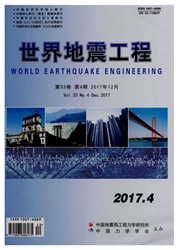

 中文摘要:
中文摘要:
A building retrofitted with wing walls in the bottom story, which was damaged during the 2008 M8.0 Wenchuan earthquake in China, is introduced and a corresponding 1/4 scale wing wall-frame model was subjected to shake table motions to study the seismic behavior of this retrofitted structural system. The results show that wing walls can effectively protect columns from damage by moving areas that bear reciprocating tension and compression to the sections of the wing walls, thus achieving an extra measure of seismic fortification. A ‘strong column-weak beam’ mechanism was realized, the flexural rigidity of the vertical member was strengthened, and a more uniform distribution of deformation among all the stories was measured. In addition, the joint between the wing walls and the beams suffered severe damage during the tests, due to an area of local stress concentration. A longer area of intensive stirrup is suggested in the end of the beams.
 英文摘要:
英文摘要:
A building retrofitted with wing walls in the bottom story, which was damaged during the 2008 M8.0 Wenchuan earthquake in China, is introduced and a corresponding 1/4 scale wing wall-frame model was subjected to shake table motions to study the seismic behavior of this retrofitted structural system. The results show that wing walls can effectively protect columns from damage by moving areas that bear reciprocating tension and compression to the sections of the wing walls, thus achieving an extra measure of seismic fortification. A ‘strong column-weak beam' mechanism was realized, the flexural rigidity of the vertical member was strengthened, and a more uniform distribution of deformation among all the stories was measured. In addition, the joint between the wing walls and the beams suffered severe damage during the tests, due to an area of local stress concentration. A longer area of intensive stirrup is suggested in the end of the beams.
 同期刊论文项目
同期刊论文项目
 同项目期刊论文
同项目期刊论文
 期刊信息
期刊信息
